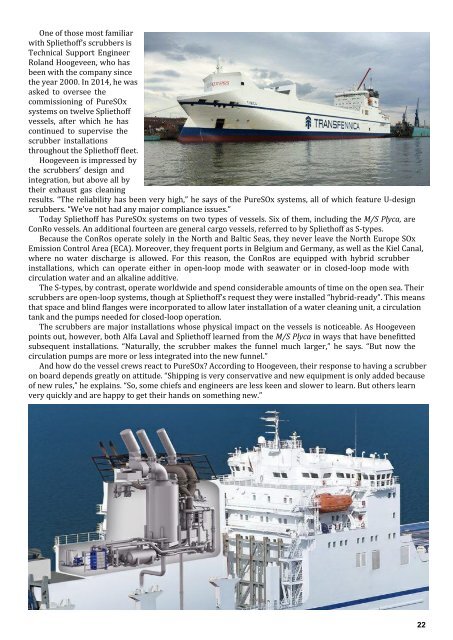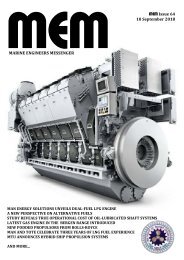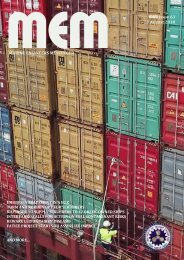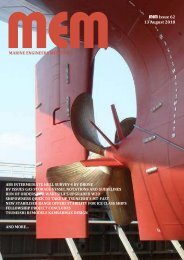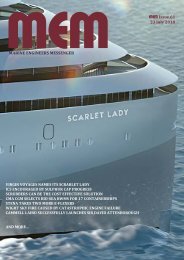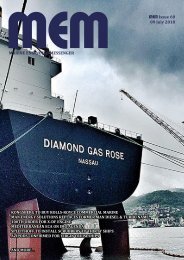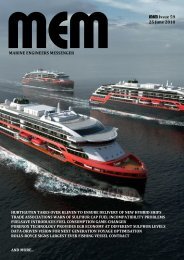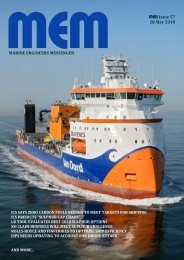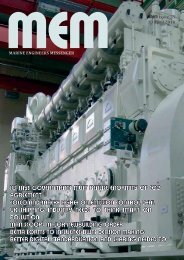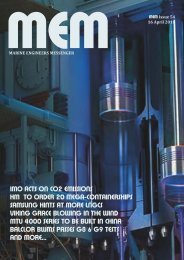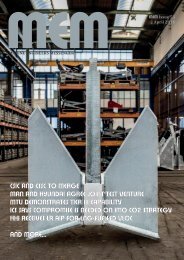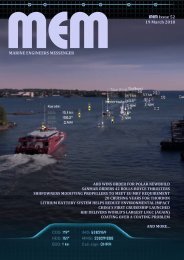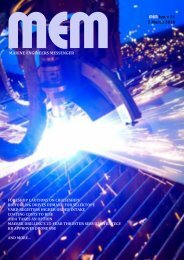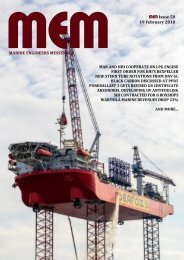MEM39
Marine Engineers Messenger, Volume 2, Issue 39
Marine Engineers Messenger, Volume 2, Issue 39
Create successful ePaper yourself
Turn your PDF publications into a flip-book with our unique Google optimized e-Paper software.
One of those most familiar<br />
with Spliethoff’s scrubbers is<br />
Technical Support Engineer<br />
Roland Hoogeveen, who has<br />
been with the company since<br />
the year 2000. In 2014, he was<br />
asked to oversee the<br />
commissioning of PureSOx<br />
systems on twelve Spliethoff<br />
vessels, after which he has<br />
continued to supervise the<br />
scrubber installations<br />
throughout the Spliethoff fleet.<br />
Hoogeveen is impressed by<br />
the scrubbers’ design and<br />
integration, but above all by<br />
their exhaust gas cleaning<br />
results. “The reliability has been very high,” he says of the PureSOx systems, all of which feature U-design<br />
scrubbers. “We’ve not had any major compliance issues.”<br />
Today Spliethoff has PureSOx systems on two types of vessels. Six of them, including the M/S Plyca, are<br />
ConRo vessels. An additional fourteen are general cargo vessels, referred to by Spliethoff as S-types.<br />
Because the ConRos operate solely in the North and Baltic Seas, they never leave the North Europe SOx<br />
Emission Control Area (ECA). Moreover, they frequent ports in Belgium and Germany, as well as the Kiel Canal,<br />
where no water discharge is allowed. For this reason, the ConRos are equipped with hybrid scrubber<br />
installations, which can operate either in open-loop mode with seawater or in closed-loop mode with<br />
circulation water and an alkaline additive.<br />
The S-types, by contrast, operate worldwide and spend considerable amounts of time on the open sea. Their<br />
scrubbers are open-loop systems, though at Spliethoff’s request they were installed “hybrid-ready”. This means<br />
that space and blind flanges were incorporated to allow later installation of a water cleaning unit, a circulation<br />
tank and the pumps needed for closed-loop operation.<br />
The scrubbers are major installations whose physical impact on the vessels is noticeable. As Hoogeveen<br />
points out, however, both Alfa Laval and Spliethoff learned from the M/S Plyca in ways that have benefitted<br />
subsequent installations. “Naturally, the scrubber makes the funnel much larger,” he says. “But now the<br />
circulation pumps are more or less integrated into the new funnel.”<br />
And how do the vessel crews react to PureSOx? According to Hoogeveen, their response to having a scrubber<br />
on board depends greatly on attitude. “Shipping is very conservative and new equipment is only added because<br />
of new rules,” he explains. “So, some chiefs and engineers are less keen and slower to learn. But others learn<br />
very quickly and are happy to get their hands on something new.”<br />
22


